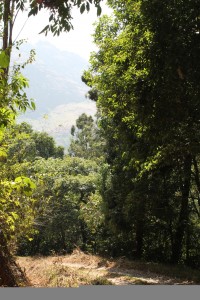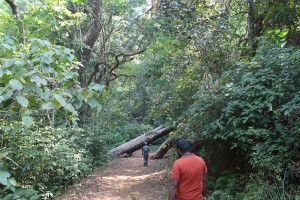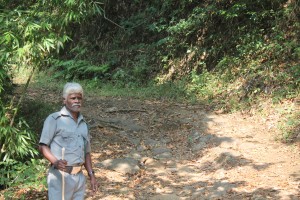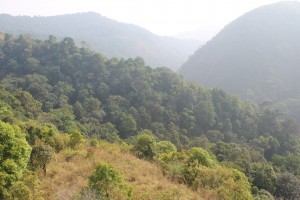We bundled ourselves into the jeep, and into Silent Valley. Well, actually, two jeeps. We tried being cheap, and tried to squeeze ourselves into one, but the guys at the Information Center took one look at the hubby and me, and flatly refused. I explained that the hubby was not a prototype for the rest of the group, but the damage was already done.
Two jeeps, it was. And that’s when I met Yesappan. Yesappan is a small, dark, grey haired man who has been working as a Forest Guard in Silent Valley for the past 40 years. He greeted us with warmth, and was thrilled to know that I was a malayali. As soon as we introduced ourselves, he entrusted the role of a translator to me. As we entered the buffer zone, Yesappan started a running commentary on the history of the forest, and also about the flora and fauna in the forest. In the beginning, I have to mention that I was a bit irritated. I have never liked travelling with a guide, only because I always thought that having an outsider doesn’t allow me to soak in the atmosphere of the place, or rather that the commentary distracts you from observing things. So I was a bit annoyed, because I would have preferred to just look out of the jeep and listen to the quiet of the jungle. But Yesappan soon won me over with his genuine love for the forest and the land. After the initial hiccups, I did settle down to conversation with Yesappan. And he was a treasure trove of information – right from showing us different kinds of plants, and explaining their medicinal and scientific importance, to explaining why the forest was named Silent Valley, Yesappan enthralled us with his stories.
The stories were enthralling, but the forest was even better. As the road cut across the dense forest, we peeked out of the jeep, looking at trees and foliage which looked majestic and untroubled even in the sultry heat of the sun. The sun filtered through the branches and made patterns on the leaves. There were different shades of green, and as the breeze changed, the shades changed patterns. The views were also different; sometimes the road would snake in through a thick clump of trees and all you could see was the road ahead, and a cloak of green around you. And then sometimes the road would emerge from the clump, and you would reach a vantage point where you could see a whole expanse of mountains and valleys around you. Miles and miles and miles of green forest kissing the blue sky in gentle ardor. The air was laden with the weight of summer, but it smelt of trees and green. Even as the jeep blew up the dust on the road, we drew in big gulps of the forest air, the oxygen soothing our weary parched city-bred souls.
Yesappan was of course in his element, as he proudly showed off his forest. And I suppose, I should to. Silent Valley was so named by the British because – well, obviously, because of the quiet in the jungle – they were amazed by the absence of cicada in the forest during early years when they explored the valley. The place is actually named Indira Gandhi National Park. Locals in the area refer to the forest as “Sairandri vanam”. Sairandri is the other name of Panchali, wife of the Pandavas. Legends say that Pandavas lived a few days here during their thirteen years of exile and thus the forest got the name Sairandri vanam. It’s a beautiful name, isn’t it? As beautiful as the forest. It was the start of the summer, and with no rains for the past two months, there were definitely brown patches, and the occasionally burnt grass. But we could hear the sound of mountain streams, and Yesappan directed us to one small waterfall. The water was ice cold and I sighed in pleasure as the water soothed my parched throat. Yesappan of course proudly explained about the pure the mountain water was, and how it even had medicinal properties. This of course raised a debate on water consevation, which was quite hilarious in the fact that the guys would talk in English, and Yesappan would contribute in Malayalam, and I would attempt to translate it as best as I could. There was this collective enthusiasm and passion for the subject, just that language made it so complicated and funny. 🙂
After a journey of the 23kms in the buffer zone, we finally entered the core zone of the forest. As Yesappan pointed out, we realized that the forest was really dense here. Trees were taller, and their branches intertwined with each other, they formed a rich cloak of green around us. 1 km into the forest, there’s a watch tower, which is where the jeeps stop. From there, we accompanied Yesappan towards Kunthi River. It is around two kilometres away from the watchtower. I know I had been talking about a good old trek, but even this 2km walk was exhausting for me. Ignoring the “I told you so” looks given by hubby, I wobbled up and down the path to the river. Even as I huffed and puffed, I couldn’t help notice the huge variety of plants and trees. Yes, the biodiversity everybody was talking about. We also saw a bison, some nilgiri langurs, and the malabar giant squirrel. Butterflies flitted around us, and we learnt that there were hundred plus species of butterflies in the forest. Even for someone as prosaic as me, that’s an amazing fact. Think about it – hundreds of kinds of butterflies flitting around a forest – almost magical, isn’t it?
We finally reached the Kunti river. This is when the silence in Silent Valley really hits you. As you watch the river gurgle its way down the rocks and pebbles, cutting a clearing between the trees on both shores, you understand how precious all this is. The trees, the forest, the birds, the river – everything that you have taken for granted – and none of which costs money – is actually giving you happiness. Undemanding, soul-stirring happiness.
We walked back to the watch-tower and by now I was a quivering heap of arms and legs. Some of the guys climbed up the 200 steps to the top of the tower, and went gaga over the views. I have to tell you that it was very very ugly, so totally not worth it. Why would you want to see a panoramic view of thick rain forests, spread over an expanse of mountains and valleys? Why would you want to climb 200 steps and reach a height where silence and breeze compete to get the best views? Why would you want to touch the blue sky, as it spread across the mountains and then vanished into the horizon? So yeah, some of the guys were stupid enough to do that, while I carefully placed each arm and leg on the ground, and checked if they were in working condition.
By now it was evening and time to head back. As the sun went down, and the trees sighed in the cool breeze, we relaxed in the jeep, engaging in happy conversation with Yesappan. And he had more stories. And as we listened, we couldn’t help thinking how uncomplicated life here was. And then P rightly corrected me, it was not about how uncomplicated life was, it was about Yesappan chose to keep his life uncomplicated. I have always believed that people who travel are the ones who have an open mind. The farthest Yesappan had travelled was Coimbatore, and yet he was much more open-minded than a lot of travelers I know. He loved his forest with the same devotion that he had for Jesus after whom he was named; he loved his Hindu wife Lakshmi, their kids and grandkids and only demanded that they respect the forest as much as he did. He is 64 and he bounds across the forest every day, not eyeing it for the riches it provided him, but for the peace and benevolence it bestowed on him. Yes, I know that there’s the danger of romanticizing the picture, but it was already a pretty picture, wasn’t it?
Getting back to Silent Valley; I have to agree that the hubby was right. This was the one of the places where we got it right. Where tourism did not mean destroying the natural resources in the area; where raising employment did not mean badly constructed resorts; where raising awareness did not mean subduing local voices; and where government apathy did not cause a natural disaster. I liked the fact that no new houses or resorts can be constructed in the buffer zone. I liked the fact that not more than 100 tourists are allowed into the forest every day, and they have to be always accompanied by a guide. I liked the fact that there was not bit of plastic lying around in the forest. I like the fact the adivasis in the jungle are rehabilitated here, and given work on the coffee plantations being maintained by the government. Yes, we got it right here.
And yet, we actually came quite close to disaster here. The hubby was telling me about how in 1973 the valley became the focal point of “Save Silent Valley” campaign, when the Kerala State Electricity Board decided to implement the Silent Valley Hydro-Electric Project (SVHEP) centered on a dam across the Kunthi river. The resulting reservoir would have submerged several kilometers of the forest, and threatened the wildlife here. Thankfully, the project was abandoned, but we did come quite close to disaster. Very close. Today, Silent Valley is in good shape, and I would like to think, in good hands. A civil society which appreciates its natural wealth, understands is relevance, and is ready to fight for it. Yes, Silent Valley is in good hands. I hope future generations will treat it with the same reverence as the past did. I would like to believe they will…
Useful Links:
http://en.wikipedia.org/wiki/Silent_Valley_National_Park
http://forest.kerala.gov.in/index.php?option=com_content&view=article&id=314&Itemid=121



